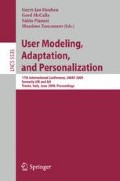Abstract
Knowledge about computer users is very beneficial for assisting them, predicting their future actions or detecting masqueraders. In this paper, an approach for creating and recognizing automatically the behavior profile of a user from the commands (s)he types in a command-line interface, is presented.
Specifically, in this research, a computer user behavior is represented as a sequence of UNIX commands. This sequence is transformed into a distribution of relevant subsequences in order to find out a profile that defines its behavior. Then, statistical methods are used for recognizing a user from the commands (s)he types. The experiment results, using 2 different sources of UNIX command data, show that a system based on our approach can efficiently recognize a UNIX user. In addition, a comparison with a HMM-base method is done.
Because a user profile usually changes constantly, we also propose a method to keep up to date the created profiles using an age-based mechanism.
Access this chapter
Tax calculation will be finalised at checkout
Purchases are for personal use only
Preview
Unable to display preview. Download preview PDF.
References
Mulcahy, N.J., Call, J.: Apes save tools for future use. Science 312(5776), 1038–1040 (2006)
Hackos, J.T., Redish, J.C.: User and Task Analysis for Interface Design. Wiley, Chichester (1998)
Spiliopoulou, M., Faulstich, L.C.: Wum: A web utilization miner. In: Proceedings of EDBT Workshop WebDB 1998, pp. 109–115. Springer, Heidelberg (1998)
Wexelblat, A.: An environment for aiding information-browsing tasks. In: Proc. of AAAI Spring Symposium on Acquisition, Learning and Demonstration: Automating Tasks for Users. AAAI Press, Menlo Park (1996)
Macedo, A.A., Truong, K.N., Camacho-Guerrero, J.A., da GraÇa Pimentel, M.: Automatically sharing web experiences through a hyperdocument recommender system. In: HYPERTEXT 2003, pp. 48–56. ACM, New York (2003)
Godoy, D., Amandi, A.: User profiling for web page filtering. IEEE Internet Computing 9(4), 56–64 (2005)
Pepyne, D.L., Hu, J., Gong, W.: User profiling for computer security. In: Proceedings of the American Control Conference, pp. 982–987 (2004)
Coull, S.E., Branch, J.W., Szymanski, B.K., Breimer, E.: Intrusion detection: A bioinformatics approach. In: Omondi, A.R., Sedukhin, S.G. (eds.) ACSAC 2003. LNCS, vol. 2823, pp. 24–33. Springer, Heidelberg (2003)
Schonlau, M., Dumouchel, W., Ju, W.H., Karr, A.F.: Theus, Computer Intrusion: Detecting Masquerades. Statistical Science 16, 58–74 (2001)
Anderson, J.: Learning and Memory: An Integrated Approach. John Wiley and Sons, New York (1995)
Horman, Y., Kaminka, G.A.: Removing biases in unsupervised learning of sequential patterns. Intelligent Data Analysis 11(5), 457–480 (2007)
Lane, T., Brodley, C.E.: Temporal sequence learning and data reduction for anomaly detection. In: CCS 1998, pp. 150–158. ACM, New York (1998)
Riley, P., Veloso, M.M.: On behavior classification in adversarial environments. In: DARS, pp. 371–380
Iglesias, J.A., Ledezma, A., Sanchis, A.: Sequence classification using statistical pattern recognition. In: Berthold, M.R., Shawe-Taylor, J., Lavrač, N. (eds.) IDA 2007. LNCS, vol. 4723, pp. 207–218. Springer, Heidelberg (2007)
Fredkin, E.: Trie memory. Comm. ACM 3(9), 490–499 (1960)
Kaminka, G.A., Fidanboylu, M., Chang, A., Veloso, M.M.: Learning the sequential coordinated behavior of teams from observations. In: Kaminka, G.A., Lima, P.U., Rojas, R. (eds.) RoboCup 2002. LNCS, vol. 2752, pp. 111–125. Springer, Heidelberg (2003)
Iglesias, J.A., Ledezma, A., Sanchis, A., Kaminka, G.A.: Classifying efficiently the behavior of a soccer team. In: Burgard, W., et al. (eds.) Intelligent Autonomous Systems 10. IAS-10, pp. 316–323 (2008)
Agrawal, R., Srikant, R.: Mining sequential patterns. In: Eleventh International Conference on Data Engineering, Taipei, Taiwan, pp. 3–14 (1995)
Blake, C., Newman, D.J., Hettich, S., Merz, C.: UCI repository of machine learning databases (1998)
Han, K., Veloso, M.: Automated robot behavior recognition applied to robotic soccer. In: IJCAI 1999 Workshop on Team Behaviors and Plan Recognition (1999)
Chung, P.-C., Liu, C.-D.: A daily behavior enabled hidden markov model for human behavior understanding. Pattern Recognition 41(5), 1572–1580 (2008)
Lane, T.: Hidden Markov Models for Human-computer interface modeling. In: Proceedings of IJCAI 1999 Workshop on Learning About Users, pp. 35–44 (1999)
Lane, T., Brodley, C.E.: An empirical study of two approaches to sequence learning for anomaly detection. Machine Learning 51(1), 73–107 (2003)
Bengio, Y.: Markovian models for sequential data. Neural Computing Surveys 2, 129–162 (1999)
Kanungo, T.: Umdhmm: A hidden markov model toolkit. In: Extended Finite State Models of Language. Cambridge Univ. Press, Cambridge (1999)
Angelov, P., Zhou, X.: Evolving fuzzy-rule-based classifiers from data streams. IEEE Transactions on Fuzzy Systems 16(6), 1462–1475 (2008)
Angelov, P.: Rule-based Models: A Tool for Design of Flexible Adaptive Systems. Springer, Heidelberg (2002)
Author information
Authors and Affiliations
Editor information
Editors and Affiliations
Rights and permissions
Copyright information
© 2009 Springer-Verlag Berlin Heidelberg
About this paper
Cite this paper
Iglesias, J.A., Ledezma, A., Sanchis, A. (2009). Creating User Profiles from a Command-Line Interface: A Statistical Approach. In: Houben, GJ., McCalla, G., Pianesi, F., Zancanaro, M. (eds) User Modeling, Adaptation, and Personalization. UMAP 2009. Lecture Notes in Computer Science, vol 5535. Springer, Berlin, Heidelberg. https://doi.org/10.1007/978-3-642-02247-0_11
Download citation
DOI: https://doi.org/10.1007/978-3-642-02247-0_11
Publisher Name: Springer, Berlin, Heidelberg
Print ISBN: 978-3-642-02246-3
Online ISBN: 978-3-642-02247-0
eBook Packages: Computer ScienceComputer Science (R0)

